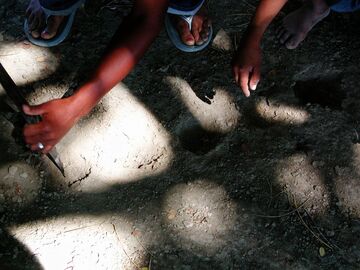Pit → German, Portuguese.
The pits (also called holes, small holes, houses) are hollows of mancala boards, which contain the playing pieces. The pits are a characteristic feature of mancala games, which, for that reason, are also called "pit-and-pebble-games" in English.
The playing pits are used in actual game play, while the stores, if they exist at all, are used to store the captured counters.

Digging holes in the earth to play Hoyito
Pits are usually carved in wooden boards, while nomads and children often just dug them into the ground. Children in Madagascar draw them on a sheet of paper and, as in Yunnan, south-eastern China and the Dominican Republic, with chalk on concrete. The number of playing pits varies depending on the game, from two to 160. They are arranged in rows, usually two or four, but sometimes also in a circular fashion (i.e. Sat-gol) or other patterns (i.e. Fergen Goobalay).
The size of the pits depends on the number and size of the counters, which are typically used in the game. In Europe, industrially produced game boards often have rather small counters and playing pits so that the games can be sold cheaper, which, however, makes the playing cumbersome. Similar can happen with board made for tourists; usually they have pits that are too small in relation to the size of the seeds. Traditional boards usually have playing which have at least a diameter of 6 cm.
The shape of the pits is usually circular, but they can sometimes also be squarish (i.e. Omweso). In Bao most pits are round, except two ones, which are square or diabolo-shaped and have a special function.
Names and Meanings of Pits
The playing pits have numerous symbolic meanings. As many mancala games use 12 playing pits, it was assumed by the French ethnographs Marcel Griaule and Germaine Dieterlen in 1951 that the pits represent the months of a year, so to speak constitute a cosmological symbol. This interpretation has been later disputed by other scholars.
In Space Walk, a modern mancala game, the playing pits signify planets.
More conclusions can be obtained from the names used in some traditional games:
| Game | Origin (Ethnic Group) | Local Name for "Pit" | English Meaning |
| Andada | Eritrea (Kunama) | ita | house |
| Anywoli | Eritrea (Kunama) | oto (pl.: udi) | house |
| Bao la Kimasai | Tanzania (Masai) | enkang (pl.: inkang'ite) | enclosure for cattle |
| Bao | East Africa (Bajun, Swahili) | shimo (pl.: mashimo) (round pits); nyumba (square pits) | hole (round pits); house (square pits) |
| Bulto | Ethiopia (Borana) | mona | hurdling |
| Imbelece | Congo (Genya) | moseka | girl |
| Songo Ewondo | Cameroon, Gaberone (Ekang) | nda | house |
| Toguz Kumalak | Central Asia (Kazakhs, Kyrgyz, Turkmen) | uj | cow |
| Um ed-Dyar | Mauritania (Hassaniya) | dar (pl.: dyar) | inhabited place |
| Vai Lung Thlan | India (Mizo) | thlan | grave |
Pit Ownership
In most mancala games pits are owned (or "controlled") by one player, which distinguishes these games from most other board games. Usually each player owns a part of the board. A contiguous sequence of holes controlled by a player is called his "side" or "sector" (Eagle). A player may begin his turn only from a pit he owns (an exception is Tap-urdy). Furthermore, seeds can usually only be captured on the opponent's side.
In most two-row games one row is controlled by each player, in three-row boards each player owns one and a half row, and in four-row boards each player controls the two rows on his side. However, there are a few games, aside from solitaires, which have shared pits, that is, the whole board is owned by both players.
Following the terminology of game theory, pits, which are controlled by just one player could be called "partisan pits", while those with communal ownership could be called "socialist pits".
In most mancala games, the ownership of pits doesn't change during a game. It is possible, however, to lose and sometimes also to win pits in mancala variants that are played in rounds. Grand Coastal Oh-Wah-Ree is exceptional in so far that pits can be conquered during a game, in fact, he who has conquered more holes eventually wins.
Further Distincion
The playing pits must be distinguished from "cup marks", petroglyphs carved in rocks and buildings. They were found in the Sahara, in Egypt and Jordan (Petra), on Cyprus and Sri Lanka. Their meaning and relationship to mancala games is still discussed.
References
- Eagle, V. A.
- On Some Newly Described Mancala Games from Yunnan Province, China, and the Definition of a Genus in the Family of Mancala Games. In: Voogt, A. J. de (Ed.). New Approaches to Board Games Research: Asian Origins and Future Perspectives (Working Paper Serie 3). Leiden (Netherlands) 1995: 48-62.
- Griaule, M. & Dieterlen, G.
- Signes Graphiques Soudanais. Hermann, Paris (France) 1951.
- Van Binsbergen, W.
- Board-games and Divination in Global Cultural History: A Theoretical, Comparative and Historical Perspective on Mankala and Geomancy in Africa and Asia. Rotterdam & Leiden (Netherlands) 1996. -- [Postulated relationship between cup marks and mancala games]
Copyright
© Wikimanqala.
By: Ralf Gering.
Under the CC by-sa 2.5.